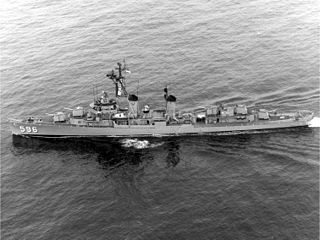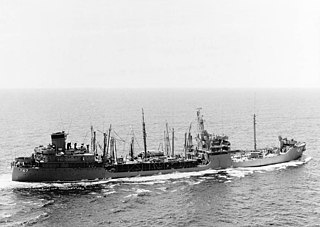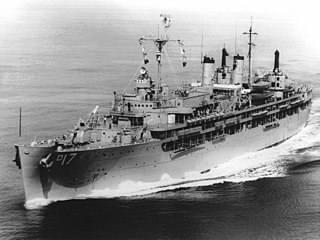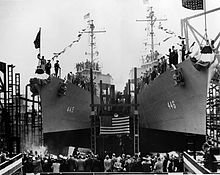
USS Arnold J. Isbell (DD-869), a Gearing-class destroyer, was the only ship of the United States Navy to be named for Arnold J. Isbell, an aircraft carrier captain during World War II. The ship was laid down on 14 March 1945 at Staten Island, New York, by Bethlehem Mariners Harbor, launched on 6 August 1945 and commissioned on 5 January 1946. Constructed too late to see action in World War II, the vessel initially served as a training ship with the United States Atlantic Fleet, before transferring to the Pacific and deploying to Korea during the Korean War and off the Vietnam coast during the Vietnam War. In 1972 Arnold J. Isbell was made part of the reserve training fleet and in 1974, sold to Greece where the ship was renamed Satchouris and served with the Hellenic Navy until being sold for scrap in 2002.

USS Orleck (DD-886), is a Gearing-class destroyer that was in service with the United States Navy from 1945 to 1982. In October 1982 she was sold to Turkey and renamed Yücetepe. After her final decommissioning the Turkish government transferred Yücetepe to the Southeast Texas War Memorial and Heritage Foundation at Orange, Texas, where she was berthed as a museum ship. The Orleck Foundation then decided to move the ship to the Calcasieu River in Lake Charles, Louisiana. On 26 March 2022, she arrived in Jacksonville, FL, where she will serve as a Naval Museum on the downtown riverfront.

USS John S. McCain (DL-3/DDG-36) was the second Mitscher-class destroyer leader in the United States Navy. Commissioned in 1953, she was later converted into a guided missile destroyer and served until 1978. She was sold for scrap in 1979.

The Battle of Kula Gulf took place in the early hours of 6 July 1943 during World War II. The battle involved United States and Japanese ships off the eastern coast of Kolombangara in the Solomon Islands. It took place during the early stages of the New Georgia campaign when a Japanese force landing reinforcements at Vila was intercepted by a force of US Navy cruisers and destroyers. One US light cruiser was sunk during the engagement while two Japanese destroyers were sunk and two more were damaged. The Japanese withdrew after the engagement, having landed 1,600 troops.

USS Honolulu (CL-48) of the United States Navy was a Brooklyn-class light cruiser active in the Pacific War. Honolulu was launched in 1937 and commissioned in 1938. The ship served in the Battle of Tassafaronga, the Battle of Kula Gulf, the Battle of Kolombangara and the Battle of Peleliu. She was taken out of action by serious torpedo damage just before the Battle of Leyte Gulf. She was repaired, but not in time to rejoin the war. She was decommissioned in 1947 and was held in reserve until she was scrapped in 1959.

USS Collett (DD-730) was a World War II-era Allen M. Sumner-class destroyer in the service of the United States Navy.

USS Jenkins (DD-447) was a Fletcher-class destroyer in the service of the United States Navy, the second ship named after Rear Admiral Thornton A. Jenkins. Beginning service during World War II, the destroyer saw action in the Pacific theatre. Jenkins was placed in reserve following the end of the war, until 1951, when the ship was reactivated for the Korean War. She served in the western Pacific until 1969 when the destroyer was taken out of service and sold for scrap in 1971.

USS Nicholas (DD/DDE-449) was a Fletcher-class destroyer of the United States Navy, serving for a total of 27 years, including through most of World War II, the Korean War, and the Vietnam War. She was the second Navy ship to be named for Major Samuel Nicholas.

USS O'Bannon (DD/DDE-450), a Fletcher-class destroyer, was the second ship of the United States Navy to be named after Lieutenant Presley O'Bannon (1784–1850), the Marine Corps's "hero of Derna".

USS Agerholm (DD-826) was a Gearing-class destroyer of the United States Navy. She was the only ship named for Harold Crist Agerholm, a Private First Class (Pfc.) in the 2nd Marine Division of the United States Marine Corps. He was killed during the assault on Saipan, and posthumously awarded the Medal of Honor.

USS Taylor (DD/DDE-468) was a Fletcher-class destroyer of the United States Navy, named for Rear Admiral William Rogers Taylor (1811–1889). She was laid down on 28 August 1941 at Bath, Maine, by the Bath Iron Works Corp.; launched on 7 June 1942, sponsored by Mrs. H. A. Baldridge; and commissioned on 28 August 1942 at the Charlestown Navy Yard near Boston, Mass.

USS Shields (DD-596), was a Fletcher-class destroyer of the United States Navy.

USS Renshaw (DD/DDE-499), a Fletcher-class destroyer, was the third ship of the United States Navy of that name, in honor of Commander William B. Renshaw.

USS John A. Bole (DD-755), was an Allen M. Sumner-class destroyer of the United States Navy.

USS Stoddard (DD-566) was a Fletcher-class destroyer of the United States Navy, named for Master's Mate James Stoddard, who was awarded the Medal of Honor during the Civil War. She was the last Fletcher to be stricken from the U.S. Navy, in 1975.

USS Neches (AO-47) was a Kennebec-class oiler in the United States Navy during World War II and the Vietnam War. She was the second U.S. Navy ship named for the Neches River in eastern Texas.

USS Ozbourn (DD-846) was a Gearing-class destroyer in the United States Navy during the Korean War and the Vietnam War. She was named for Marine Private Joseph W. Ozbourn (1919–1944), who was awarded the Medal of Honor posthumously for his "great personal valor" during the Battle of Tinian.

USS Piedmont (AD–17) was a Dixie-class destroyer tender built during World War II for the United States Navy. Her task was to service destroyers in, or near, battle areas and to keep them fit for duty. She served in the Pacific Ocean during World War II, the Cold War, the Korean War, and the Vietnam War. For her work in battle areas, the ship was awarded four battle stars for her Korean War efforts and one for Vietnam War service.

USS Haverfield (DE-393) was an Edsall-class destroyer escort built for the U.S. Navy during World War II. She served in the Atlantic Ocean and the Pacific Ocean and provided destroyer escort protection against submarine and air attack for Navy vessels and convoys.
























